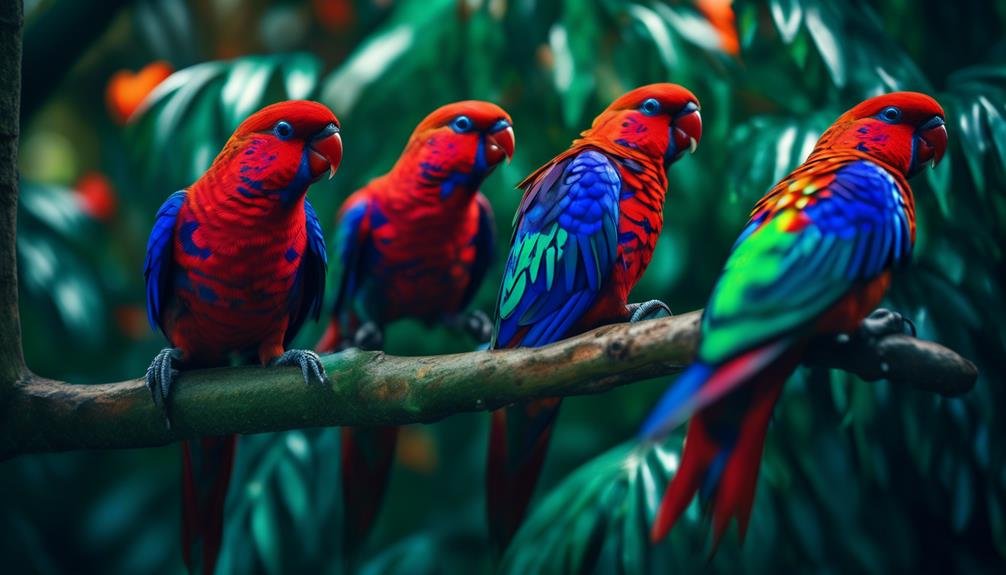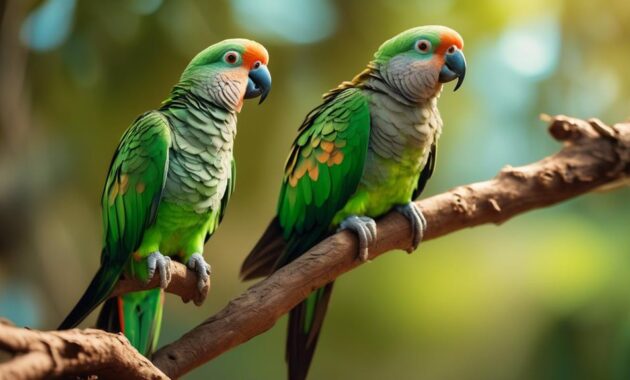
Step into a world where vibrant plumage and enchanting melodies collide – the realm of the Crimson Rosellas, the whistling wonders of the avian kingdom. These captivating creatures, with their stunning crimson red bodies and melodious tunes, are a sight to behold.
But there’s more to these birds than meets the eye. As you begin to uncover their secrets, you’ll be drawn into a world of color mutations, vocal abilities, and the importance of their well-being.
So, prepare to be captivated as we unravel the mysteries of the vibrant Crimson Rosellas and discover why they truly are the whistling wonders.
Key Takeaways
- Crimson Rosellas are medium-sized parrots known for their vibrant crimson red plumage.
- They have a lifespan of approximately 25 years and can live longer with proper care and attention to hygiene, living conditions, diet, and mental stimulation.
- Crimson Rosellas belong to the Rosella species and are popular in aviculture.
- They are vocal birds with whistling abilities and can mimic tunes and sounds, but their high-pitched calls may not be suitable for apartment living.
Size and Lifespan
Crimson Rosellas are medium-sized parrots, measuring approximately 14 inches in length. They have a medium-sized body, weighing around 6 ounces on average. The size of their tail contributes to their overall length. Males can be larger than females.
In terms of lifespan, they typically live for about 25 years, but with proper care, they can live even longer. Good hygiene, living conditions, a balanced diet, and mental stimulation are all important factors in ensuring their longevity. Regular veterinary check-ups also play a crucial role in detecting and preventing health issues.
Taking care of these aspects will contribute to the overall well-being and happiness of your Crimson Rosella.
Bird Species and Aviculture

One popular aspect of Crimson Rosellas is their belonging to the Rosella species, making them a sought-after choice in aviculture.
Rosellas, including Crimson Rosellas, are a type of parrot known for their colorful plumage. Other species in the same family include Eastern Rosella and Kakariki.
Crimson Rosellas have a predominantly deep crimson red body, with bright purple chin and tail feathers. Their primary flight feathers also have a purple color, while the wing and back feathers are mostly black with red borders.
In aviculture, blue, yellow, and white color mutations have been created for Crimson Rosellas. Due to their vibrant colors and vocal abilities, these birds are popular among bird enthusiasts looking to keep them as pets.
Colors

With their vibrant plumage, Crimson Rosellas display a stunning array of colors. Their bodies are predominantly deep crimson red, while their chin and tail feathers are bright purple. The primary flight feathers also have a purple hue. The wing and back feathers are mostly black with red borders, creating a striking contrast.
In aviculture, color mutations have been created, resulting in blue, yellow, and white variations of the Crimson Rosella. These colorful combinations make them even more captivating to observe.
Whether in their natural crimson red or in the unique color mutations, the Crimson Rosella truly stands out with its vibrant and eye-catching appearance.
Sounds

When it comes to their vocal abilities, Crimson Rosellas are known for their whistling talents and the ability to mimic tunes and sounds. These vibrant birds are highly vocal and produce natural calls that can be heard from a distance.
Their whistling abilities are particularly impressive, as they can mimic various tunes and sounds with accuracy. However, it’s important to note that when Crimson Rosellas feel alarmed or neglected, they may produce high-pitched, shrill calls.
Due to their vocal nature, they may not be suitable for apartment living, especially if you have multiple birds. So, if you’re considering adding a Crimson Rosella to your household, be prepared for their whistling wonders and the potential for a symphony of sounds.
Vocal Abilities

Crimson Rosellas showcase their impressive vocal abilities through their whistling talents and their remarkable ability to mimic various tunes and sounds. These vibrant birds are known for their melodious whistles that can be heard from a distance. They’ve a wide vocal range and can produce a variety of calls, from soft and soothing melodies to loud and piercing calls.
Their ability to mimic tunes and sounds is truly remarkable, as they can imitate the songs of other birds, the sounds of animals, and even human voices. This talent allows them to communicate with each other and adapt to their surroundings.
Whether it’s a cheerful melody or a warning call, the vocal abilities of Crimson Rosellas are truly captivating.
Housing Requirements

To ensure the well-being of Crimson Rosellas, it is important to provide them with appropriate housing conditions. Here are some key housing requirements to consider:
| Housing Requirement | Description |
|---|---|
| Cage Size | A cage that is at least 3 feet wide, 2 feet deep, and 3 feet tall is recommended to give the birds ample space to move around and stretch their wings. |
| Bar Spacing | The spacing between the bars should be no more than 1/2 inch to prevent the birds from escaping or getting stuck. |
| Perches | Provide sturdy perches of varying sizes to help exercise their feet and prevent foot problems. Natural branches are a good option. |
| Toys and Enrichment | Keep the birds mentally stimulated by providing toys such as puzzles, bells, and swings. Rotate the toys regularly to prevent boredom. |
| Location | Place the cage in a well-lit area away from drafts and direct sunlight. Ensure the temperature is kept between 65 and 80 degrees Fahrenheit. |
Diet and Nutrition

Now let’s shift our focus to the important aspect of providing a well-balanced diet and nutrition for Crimson Rosellas.
These vibrant birds require a varied diet to ensure their overall health and well-being. Start by offering a high-quality seed mix specifically formulated for parrots, which should include a variety of seeds, nuts, and grains.
Supplement their diet with fresh fruits and vegetables, such as apples, carrots, and leafy greens. Additionally, provide a source of protein, like cooked eggs or legumes, to meet their dietary needs. Remember to always provide fresh, clean water for your Crimson Rosellas to drink.
It’s crucial to offer a diverse range of foods to ensure they receive all the necessary nutrients. Consult with a avian veterinarian or an experienced bird breeder to ensure you’re meeting their specific dietary requirements.
Health and Veterinary Care

Regular veterinary check-ups are essential for maintaining the health and well-being of your Crimson Rosellas. Just like any other pet, these vibrant birds require proper medical care to ensure they stay in optimal condition.
During these check-ups, the veterinarian will examine your Rosellas for any signs of illness or abnormalities. They’ll also provide vaccinations and treatments to prevent common avian diseases.
Additionally, the vet can offer valuable advice on nutrition, habitat, and mental stimulation, which are all crucial aspects of your Rosellas’ health.
By scheduling regular appointments, you can catch any potential health issues early and take the necessary steps to keep your feathered friends happy and thriving.
Whistling Behaviors

During your Crimson Rosellas’ regular veterinary check-ups, it’s important to observe their whistling behaviors as a way to gauge their overall well-being and contentment. Here are three key points to consider:
- Whistling as a Form of Communication: Crimson Rosellas are known for their whistling abilities and can mimic tunes and sounds. By paying attention to their whistling behaviors, you can better understand their communication patterns and whether they’re expressing happiness, alertness, or distress.
- Indicator of Mental Stimulation: Whistling is often a sign that your Crimson Rosellas are mentally stimulated and engaged. It shows that they’re content and have enough mental stimulation in their environment, which is crucial for their overall well-being and mental health.
- Changes in Whistling Patterns: Any significant changes in your Crimson Rosellas’ whistling behaviors, such as a decrease in frequency or a change in tone, could indicate underlying health issues or stress. By monitoring their whistling patterns, you can detect any potential problems early and seek appropriate veterinary care.
Hygiene and Well-being

To ensure the overall well-being of your Crimson Rosellas, maintaining proper hygiene is essential. Regular cleaning of their enclosure is necessary to prevent the buildup of dirt, waste, and bacteria. Provide fresh water daily and clean their food bowls regularly to avoid contamination.
Additionally, bathing is crucial for your Rosellas’ hygiene. Offer them a shallow dish of water for them to bathe in or mist them gently with water. This helps to keep their feathers clean and in good condition.
Furthermore, maintaining a clean and sanitized environment helps prevent the spread of diseases and parasites. Regularly inspect your birds for signs of illness or discomfort and consult a veterinarian if needed.
Color Mutations

Color mutations in Crimson Rosellas have been achieved through selective breeding in aviculture. These mutations have resulted in the creation of new and unique color variations, adding to the already stunning beauty of these birds.
Here are three notable color mutations that have been developed:
- Blue: Blue Crimson Rosellas have a striking blue coloration on their body, replacing the usual crimson red. This mutation creates a captivating contrast and adds a touch of elegance to their appearance.
- Yellow: Yellow Crimson Rosellas have a vibrant yellow plumage, transforming their overall look. This mutation gives them a bright and cheerful appearance, making them stand out in any aviary.
- White: White Crimson Rosellas have a pure white plumage, making them exceptionally rare and sought after. This mutation creates a stunning and ethereal beauty, showcasing the intricate details of their feathers.
These color mutations have expanded the range of options for aviculturists and allowed them to create even more visually stunning Crimson Rosellas.
Frequently Asked Questions
Can Crimson Rosellas Be Trained to Talk Like Some Other Parrot Species?
Yes, crimson rosellas can be trained to talk like other parrot species. With patience and consistent training, they can learn to mimic and repeat words and phrases. Proper socialization and interaction are key.
Are Crimson Rosellas Suitable for First-Time Bird Owners?
Yes, crimson rosellas can be suitable for first-time bird owners. They have a medium size, vibrant plumage, and are known for their whistling abilities. With proper care, hygiene, and a balanced diet, they can make wonderful pets.
How Often Should Crimson Rosellas Be Taken to the Veterinarian for Check-Ups?
Crimson Rosellas should be taken to the vet for regular check-ups. It’s recommended to schedule visits at least once a year. These check-ups help detect and prevent health issues, ensuring the well-being of your vibrant feathered friend.
Do Crimson Rosellas Require a Specific Type of Housing or Cage?
Crimson Rosellas require a specific type of housing or cage. Providing good hygiene, living conditions, a balanced diet, and mental stimulation contributes to their overall health and well-being. Regular veterinary check-ups help prevent health issues.
Can the Color Mutations in Crimson Rosellas Be Passed Down to Their Offspring?
Yes, color mutations in Crimson Rosellas can be passed down to their offspring. These mutations, such as blue, yellow, and white, have been created through aviculture and can be inherited by future generations.
What Are the Differences Between Eastern Rosellas and Crimson Rosellas?
Eastern Rosellas and Crimson Rosellas are both colorful Australian parrots, but they have distinct differences. Crimson Rosellas have blue cheeks and a crimson chest, while Eastern Rosellas have a vibrant eastern rosella personality, with a striking red head and yellow cheeks. Their personalities and colorations set them apart in the birdwatching world.
Conclusion
In conclusion, the Crimson Rosellas are truly remarkable creatures with their vibrant plumage and melodious songs. Their ability to mimic tunes and sounds is captivating, making them a true wonder of the avian world.
However, it’s important to remember that keeping these birds requires proper care and attention to ensure their well-being and longevity. By providing good hygiene, a balanced diet, and mental stimulation, you can create a harmonious environment for these whistling wonders to thrive.




